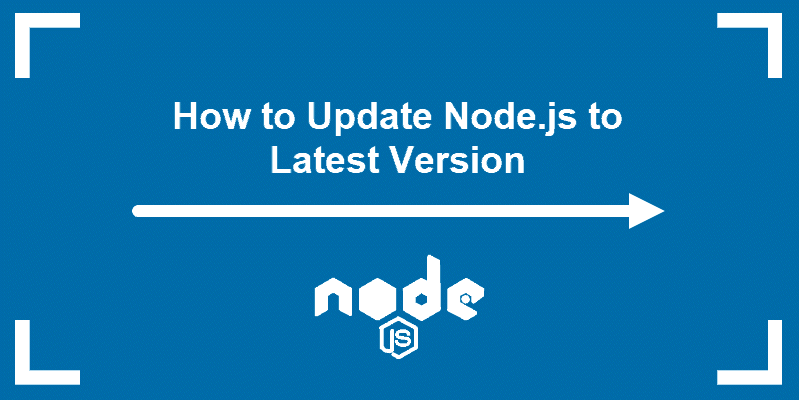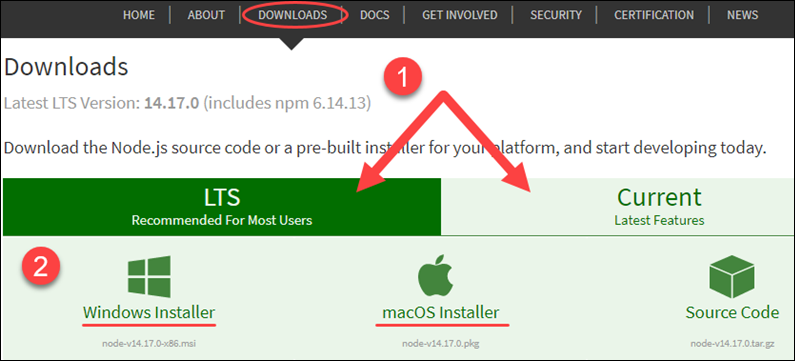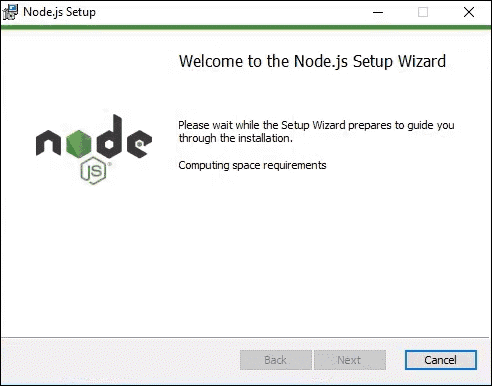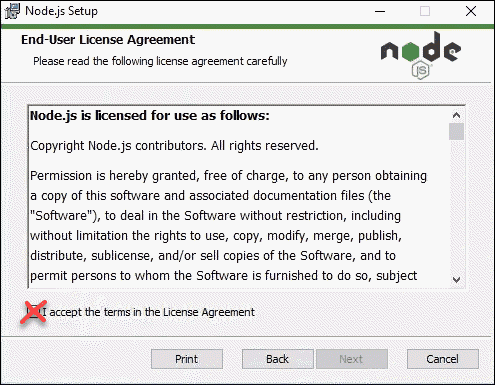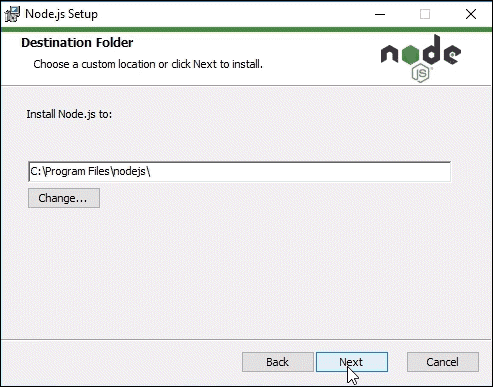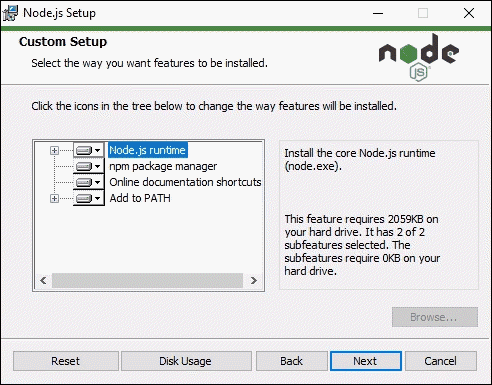- How to Update Node.JS to Latest Version (Linux, Ubuntu, OSX, Windows, Others)
- How To Update Node.JS Using Node Version Manager (NVM)
- How To Update Node Using a Package Manager
- How to Update Node (Windows/macOS) Using Installers on Nodejs.org
- How to Update Node.js to Latest Version Home » DevOps and Development » How to Update Node.js to Latest Version Node.js is an open-source JavaScript runtime environment. Since Node.js has an active community of users, minor updates of the software come out every few weeks. You may be using Node.js as a layer of the MEAN stack or in a different JS framework. Either way, make sure to update Node.js regularly to ensure system security. There are several ways to install Node.js and NPM. Likewise, there are several ways to update your Node.js version, depending on the operating system running on your machine. In this article, you will learn how to update to the latest Node.js version on Linux, Windows, and macOS. 3 Ways to Update Node.js to Latest Version on Linux Systems There are different ways to update Node.js if you are using a Linux-based system. Although using the Node Version Manager is the easiest and most recommended option, you can also update with the local package manager or by downloading the binary packages. Option 1: Update Node.js with NVM (Node Version Manager) The best way to upgrade Node.js is with NVM, a practical tool for managing multiple Node.js versions. 1. Start by updating the package repository with the command: 2. Install NVM using the curl command: Note: If you don’t have curl , install the utility by running the command: sudo apt install curl . Alternatively, you use wget and run the command: 3. Close and reopen the terminal for system to recognize the changes or run the command: 5. Then, verify if you have successfully installed NVM: 6. Before upgrading Node.js, check which version you have running on the system: 7. Now you can check for newly available releases with: 8. To install the latest version, use the nvm command with the specific Node.js version: Option 2: Update Node.js with NPM (Node Package Manager) As an alternative, you can use Node’s official package manager to update Node.js. NPM is a tool for installing and managing package dependencies. If you have Node on your system, you have NPM, as well. With the npm command, you can check running Node.js versions and install the latest release. By adding the n module, you can interactively manage Node.js versions. 1. First, clear the npm cache: 2. Install n, Node’s version manager: 3. With the n module installed, you can use it to: Install the latest stable version: Note: Some Ubuntu distros may respond with the command not found output after running the n command. To fix this issue run sudo -E env «PATH=$PATH» [command] . For example, to install the latest stable version, as in the example above, you would run sudo -E env «PATH=$PATH» n stable . Install the latest release: Install a specific version: Option 3: Update Node.js with Binary Packages Updating Node.js with binary packages is the least recommended option. However, if it is the only way you can upgrade to the latest Node.js version, follow the steps outlined below. 1. Navigate to Node’s official downloads page where you can find all available packages. There you can download the source code or pre-built installer for the LTS versions or the latest release. 2. You can either download the package from your browser or find the version number you need and add it to the wget command: 3. Next, install xz-utils used to extract the binary package: 4. Extract and install the package with the command: Update Node.js to Latest Version on Windows and macOS Updating Node.js on Windows and macOS follows the same principles. There are two simple ways to upgrade: Download the latest Node.js release from its official download page and install the new Node.js release. Install the n module and update Node.js inside the terminal window. Option 1: Update Node.js on Windows and macOS with Installer One way to update your Node.js is to go to its official download page and install the newest release. Bz doing so, the system should overwrite the older version with the updated one. 1. Navigate to the Node.js website and click on the latest stable version or the newest current release (with the latest features). 2. After deciding the version, click on the Windows or the macOS Installer, depending on the system you are using. The system downloads the package and stores it in the specified directory. 3. Once the download is complete, run the installer. 4. The Node.js Setup Wizard appears and guides you through the installation. 5. Accept the License Agreement by checking the box and click Next. 6. Choose the destination folder where you want to install Node.js. 7. Node.js allows you to select how you want to install the Node features. Change the way the features are installed by clicking on the icons in the tree. 8. With that, the latest Node.js is ready to install. Click Install to confirm, wait until the installation completes, and click Finish. 9. Check the Node.js version with the command: Note: Sometimes, the system fails to overwrite the older Node.js release and you may end up with two versions. If such problems occur, you may want to consider updating with NPM, outlined in the section below. Option 2: Update Node.js on Windows and macOS with NPM If you want to upgrade Node.js from the command line, use the n model within the npm command. The n feature allows you to interact with different Node.js versions. 1. Before updating the Node.js release, check which version you are currently using with: 2. Next, clear npm cache with the command: 3. Install n globally: 4. Now that you have n installed, you can use the module to install the latest stable release of Node.js: Alternatively, you can install the Node.js release with the latest features: Or, install a specific version number with: The best part of open-source technology is its strong community of users constantly working on upgrading the software. Источник Как обновить Node.js на Windows, Linux и Mac Этим вопросом задаются многие новички. Они не знают правильного и эффективного способа, и именно для них наш сегодняшний материал. Стоит отметить, что вариантов, как обновить Node.js достаточно много. Я постараюсь рассмотреть каждый из них в отдельности, включая, кстати, операционные системы, на которых будут производиться нужные действия. Как обновить Node.js на Windows Самым простым и очевидным способом здесь будет использование готового Bash-скрипта для Windows. С его помощью можно не только установить актуальную версию Node.js, но и произвести другие, не менее важные операции. Например, вы можете установить сразу несколько версий Node.js, и переключать их в зависимости от своих потребностей. Реализуется это через специальные команды: Само обновление же можно воспроизвести и с помощью такой последовательности действий: Очищаем кэш NPM: Устанавливаем менеджер версий Node.js n: Выбираем нужную версию Node.js: 1. Стабильная версия 2. Последняя версия 3. Установка определенной версии 4. Удаление определенной версии Помимо всего прочего, вы можете загрузить актуальную версию Node.js на официальном ресурсе Node.js. Там доступны установочные пакеты MSI, архивы zip и tar.gz, также версии для Linux и Mac. Другие способы установки и обновления Node.js на Windows В 2017 году на разных ресурсах описывают еще один, более актуальный способ, который был рекомендован одним из зарубежных “гуру” в своем блоге. Чтобы обновить Node.js нам нужно воспользоваться таким алгоритмом: Узнаем какую версию Node мы используем: Просмотрим доступные для установки версии, а также используемую: Выведем список доступных версий: Установим нужную версию (предположительно 1.1.1): Для включения более старой версии используем команду: Не могу ничего сказать по поводу эффективности данного метода, однако вы можете самостоятельно проверить его, после чего отписать в комментариях о результате. Также вы можете использовать этот, самый простой, по моему мнению, способ: 1. Запускаем cmd от имени администратора 2. Последовательно выполняем две команды: Данный способ рекомендован разработчиками npm, поэтому вам стоит обратить внимание на него. Как обновить Node.js на Linux Как и в случае с Windows, здесь мы будем использовать менеджер npm. Здесь он доступен по другому адресу на GitHub. Большая часть команд совпадает с вышеописанными, поэтому вам следует лишь повторить их, предварительно установив NPM на свою версию Linux. Кстати говоря, если вы используете Arch Linux (или производные дистрибутивы), обновление для Node.js будет установлено автоматически при следующем апгрейде системы. Как обновить Node.js на Mac И снова здесь актуален способ с NPM, вы можете использовать абсолютно те же команды, что и для Windows с Linux. Однако сейчас мы рассмотрим альтернативной вариант, подразумевающий работу с менеджером пакетов Homebrew. После установки вам достаточно будет выполнить одну единственную команду: Источник
- 3 Ways to Update Node.js to Latest Version on Linux Systems
- Option 1: Update Node.js with NVM (Node Version Manager)
- Option 2: Update Node.js with NPM (Node Package Manager)
- Option 3: Update Node.js with Binary Packages
- Update Node.js to Latest Version on Windows and macOS
- Option 1: Update Node.js on Windows and macOS with Installer
- Option 2: Update Node.js on Windows and macOS with NPM
- Как обновить Node.js на Windows, Linux и Mac
- Как обновить Node.js на Windows
- Другие способы установки и обновления Node.js на Windows
- Как обновить Node.js на Linux
- Как обновить Node.js на Mac
How to Update Node.JS to Latest Version (Linux, Ubuntu, OSX, Windows, Others)
Node.js is very popular nowadays because of it’s feature like:
- JavaScript runtime built on Chrome’s V8 JavaScript engine
- Node.js uses an event-driven, non-blocking I/O model
- Which makes it lightweight and efficient
- Node.js’ package ecosystem, npm, is the largest ecosystem of open source libraries in the world.
Because of these features, Node.Js because very popular in no time and Now its developer’s favorite language for developing Rest APIs and Building high scaling apps.
So, Today in this How to Guide, we will be discussing all the methods for updating NodeJs to Latest version in Linux Os, Ubuntu Os, Windows 7, 8, 10 and Mac Osx using NVM (Node Version Manager) and NPM (Node Package Manager). And At last, we will discuss Best way to update Node.JS
How To Update Node.JS Using Node Version Manager (NVM)
Go to NVM’s official documentation and install the script using curl or wget method.
Verify installation by using the following command,
Steps to update Node.JS using NVM:
When you’re working with multiple Node.Js utilities, sometimes you need some specific Node.js version installed, for this purpose nvm is the best option as we show the procedure below:
and, you can easily switch:
You can check what versions are currently installed with nvm ls and see what is available to install by using nvm ls-remote and you can even set default version using nvm alias default node
If you want to uninstall some version, use nvm uninstall 4.1.2
By NVM can be your Buddy if you’re troubleshooting your node.js app and you need to switch between versions.It has a lot of built-in utilities go and check it’s documentation fellas.
How To Update Node Using a Package Manager
- First Check the version of installed npm using npm -v and then update it to latest version using npm install npm@latest -g
- To update Node, you’ll need npm’s handy n module. Run this code to clear npm’s cache, install n, and install the latest stable version of Node:
- sudo npm cache clean -f sudo npm install -g n sudo n stable
- To install the latest released version, use n latest . Alternatively, you can run n #.#.# to get a specific Node version.
How to Update Node (Windows/macOS) Using Installers on Nodejs.org
- Go to NodeJs Download page, download any release you want and install it using installer for your windows or macOs.
- After installing you can verify, installation using
- npm -v node -v
- And,
You’re done, Now you have successfully installed Node.Js and NPM on your Windows or Mac Os uisng official installers.
Now, Coming to Best way to update Your Node.JS:
The best way is to use NVM, as it provides lot of built-in utilities, which are well documented and tested.
If you get any error during installation or update process, please leave the comment below and we will solve it for you.
Источник
How to Update Node.js to Latest Version
Home » DevOps and Development » How to Update Node.js to Latest Version
Node.js is an open-source JavaScript runtime environment. Since Node.js has an active community of users, minor updates of the software come out every few weeks.
You may be using Node.js as a layer of the MEAN stack or in a different JS framework. Either way, make sure to update Node.js regularly to ensure system security.
There are several ways to install Node.js and NPM. Likewise, there are several ways to update your Node.js version, depending on the operating system running on your machine.
In this article, you will learn how to update to the latest Node.js version on Linux, Windows, and macOS.
3 Ways to Update Node.js to Latest Version on Linux Systems
There are different ways to update Node.js if you are using a Linux-based system. Although using the Node Version Manager is the easiest and most recommended option, you can also update with the local package manager or by downloading the binary packages.
Option 1: Update Node.js with NVM (Node Version Manager)
The best way to upgrade Node.js is with NVM, a practical tool for managing multiple Node.js versions.
1. Start by updating the package repository with the command:
2. Install NVM using the curl command:
Note: If you don’t have curl , install the utility by running the command: sudo apt install curl .
Alternatively, you use wget and run the command:
3. Close and reopen the terminal for system to recognize the changes or run the command:
5. Then, verify if you have successfully installed NVM:
6. Before upgrading Node.js, check which version you have running on the system:
7. Now you can check for newly available releases with:
8. To install the latest version, use the nvm command with the specific Node.js version:
Option 2: Update Node.js with NPM (Node Package Manager)
As an alternative, you can use Node’s official package manager to update Node.js. NPM is a tool for installing and managing package dependencies.
If you have Node on your system, you have NPM, as well. With the npm command, you can check running Node.js versions and install the latest release.
By adding the n module, you can interactively manage Node.js versions.
1. First, clear the npm cache:
2. Install n, Node’s version manager:
3. With the n module installed, you can use it to:
Install the latest stable version:
Note: Some Ubuntu distros may respond with the command not found output after running the n command. To fix this issue run sudo -E env «PATH=$PATH» [command] . For example, to install the latest stable version, as in the example above, you would run sudo -E env «PATH=$PATH» n stable .
Install the latest release:
Install a specific version:
Option 3: Update Node.js with Binary Packages
Updating Node.js with binary packages is the least recommended option. However, if it is the only way you can upgrade to the latest Node.js version, follow the steps outlined below.
1. Navigate to Node’s official downloads page where you can find all available packages. There you can download the source code or pre-built installer for the LTS versions or the latest release.
2. You can either download the package from your browser or find the version number you need and add it to the wget command:
3. Next, install xz-utils used to extract the binary package:
4. Extract and install the package with the command:
Update Node.js to Latest Version on Windows and macOS
Updating Node.js on Windows and macOS follows the same principles.
There are two simple ways to upgrade:
- Download the latest Node.js release from its official download page and install the new Node.js release.
- Install the n module and update Node.js inside the terminal window.
Option 1: Update Node.js on Windows and macOS with Installer
One way to update your Node.js is to go to its official download page and install the newest release. Bz doing so, the system should overwrite the older version with the updated one.
1. Navigate to the Node.js website and click on the latest stable version or the newest current release (with the latest features).
2. After deciding the version, click on the Windows or the macOS Installer, depending on the system you are using. The system downloads the package and stores it in the specified directory.
3. Once the download is complete, run the installer.
4. The Node.js Setup Wizard appears and guides you through the installation.
5. Accept the License Agreement by checking the box and click Next.
6. Choose the destination folder where you want to install Node.js.
7. Node.js allows you to select how you want to install the Node features. Change the way the features are installed by clicking on the icons in the tree.
8. With that, the latest Node.js is ready to install. Click Install to confirm, wait until the installation completes, and click Finish.
9. Check the Node.js version with the command:
Note: Sometimes, the system fails to overwrite the older Node.js release and you may end up with two versions. If such problems occur, you may want to consider updating with NPM, outlined in the section below.
Option 2: Update Node.js on Windows and macOS with NPM
If you want to upgrade Node.js from the command line, use the n model within the npm command. The n feature allows you to interact with different Node.js versions.
1. Before updating the Node.js release, check which version you are currently using with:
2. Next, clear npm cache with the command:
3. Install n globally:
4. Now that you have n installed, you can use the module to install the latest stable release of Node.js:
Alternatively, you can install the Node.js release with the latest features:
Or, install a specific version number with:
The best part of open-source technology is its strong community of users constantly working on upgrading the software.
Источник
Как обновить Node.js на Windows, Linux и Mac
Этим вопросом задаются многие новички. Они не знают правильного и эффективного способа, и именно для них наш сегодняшний материал. Стоит отметить, что вариантов, как обновить Node.js достаточно много. Я постараюсь рассмотреть каждый из них в отдельности, включая, кстати, операционные системы, на которых будут производиться нужные действия.
Как обновить Node.js на Windows
Самым простым и очевидным способом здесь будет использование готового Bash-скрипта для Windows. С его помощью можно не только установить актуальную версию Node.js, но и произвести другие, не менее важные операции. Например, вы можете установить сразу несколько версий Node.js, и переключать их в зависимости от своих потребностей. Реализуется это через специальные команды:
Само обновление же можно воспроизвести и с помощью такой последовательности действий:
Очищаем кэш NPM:
Устанавливаем менеджер версий Node.js n:
Выбираем нужную версию Node.js:
1. Стабильная версия
2. Последняя версия
3. Установка определенной версии
4. Удаление определенной версии
Помимо всего прочего, вы можете загрузить актуальную версию Node.js на официальном ресурсе Node.js. Там доступны установочные пакеты MSI, архивы zip и tar.gz, также версии для Linux и Mac.
Другие способы установки и обновления Node.js на Windows
В 2017 году на разных ресурсах описывают еще один, более актуальный способ, который был рекомендован одним из зарубежных “гуру” в своем блоге. Чтобы обновить Node.js нам нужно воспользоваться таким алгоритмом:
Узнаем какую версию Node мы используем:
Просмотрим доступные для установки версии, а также используемую:
Выведем список доступных версий:
Установим нужную версию (предположительно 1.1.1):
Для включения более старой версии используем команду:
Не могу ничего сказать по поводу эффективности данного метода, однако вы можете самостоятельно проверить его, после чего отписать в комментариях о результате.
Также вы можете использовать этот, самый простой, по моему мнению, способ:
1. Запускаем cmd от имени администратора
2. Последовательно выполняем две команды:
Данный способ рекомендован разработчиками npm, поэтому вам стоит обратить внимание на него.
Как обновить Node.js на Linux
Как и в случае с Windows, здесь мы будем использовать менеджер npm. Здесь он доступен по другому адресу на GitHub. Большая часть команд совпадает с вышеописанными, поэтому вам следует лишь повторить их, предварительно установив NPM на свою версию Linux.
Кстати говоря, если вы используете Arch Linux (или производные дистрибутивы), обновление для Node.js будет установлено автоматически при следующем апгрейде системы.
Как обновить Node.js на Mac
И снова здесь актуален способ с NPM, вы можете использовать абсолютно те же команды, что и для Windows с Linux. Однако сейчас мы рассмотрим альтернативной вариант, подразумевающий работу с менеджером пакетов Homebrew.
После установки вам достаточно будет выполнить одну единственную команду:
Источник

